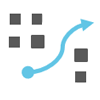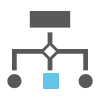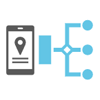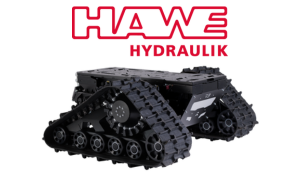Navigation, in the meaning of driving autonomously from a starting position to the target point in the room, is one of the most central capabilities for autonomous mobile robots and crucial for a smooth process operation. Navigation is a complex task due to the high amount of information that needs to be processed, but the ARTI Navigation Tool masters this task impeccably. The functionality is based upon the results of previous working steps such as mapping and localization. Navigation revolves around the issues of path planning and path following while integrating environmental information for route comprehension to find and follow the most suitable course for target achievement.
Tasks: Indoor Navigation Suite
Sensors: LIDAR (Ouster, Velodyne, SICK, …), Depth Camera (Intel Realsense, Azure Kinect, …), Inertial Measurement Units, Odometry
Robots: ROS Robotic Plattforms, Ackermann Steering, Differential Steering, Omnidirectional Designs
Navigation Graphs
Free-space Planning
Safety Compliant
Interfaces
The navigation system can interact with other participants via the following interfaces:
- VDA5050
- Web Application
- ROS 1
- Modbus
- CANopen
What's included
Modules covered

Dynamic Mapping

Obstacle Avoidance

VDA5050

Dynamic Path Planning

Object Detection

Action Pipeline

Fine Positioning

Diagnose and Error Handling

Web Application
Path Planning
Moving in dynamic environments
Dynamic path planning allows autonomous systems to adapt their behaviors in complex and quickly changing environments. It requires a high-level environmental understanding and decision-making. Our technology is able to combine several path planning approaches to enable flexibility and precision at the same time.
Features Included:
- Data Fusion: Algorithms actively process data coming from several independent sensors, to create a rich but efficient environmental representation. This ensures a highly reactive system and safe operations.
- Route Generation: The mapped area can directly be used to perform automatic route generation. This reduces the deployment time, and more robots can be instantly placed into the same operation area. There are several stages involved, from global to local path planning, down to the lowest level of trajectory following.
- Obstacle Detection and Avoidance: Robust identification of obstacles is a requirement for all further decisions made. This includes adjusting driving speeds to prevent dangerous scenarios and generating safe and efficient detour paths to increase overall throughput.
- Route Optimization: The system prioritizes optimal path selection, generating and assessing potential trajectories swiftly to minimize delays and improve response times. The free-space navigation can be guided by our navigation graph technology, which serves a similar function to highways for the robot.
- Alternatives: The navigation system also enables the usage of pre-defined trajectories. In certain environments, or within a production-like environment, fixed trajectories composed of positions and velocities might be more preferable. In an advanced navigation system, like ours, the AI can choose what’s necessary for the task.
The integration of dynamic path planning results in a navigation system capable of adapting to the complex demands of modern automated environments.
Frequently Asked Questions
FIND QUICK ANSWERS
What types of licenses do you offer?
We provide solutions for individual systems and entire product lines. Click here to learn more about our licensing system and find the best solution for your needs.
Do you offer a trial version?
Depending on the license, we provide a three-month trial phase. Upon completion, easy upgrade to a full license is possible. For further details, send us a message and we will respond as soon as possible.
How long does the integration take?
The time required for integration depends on the specific application. It can range from a few days to a couple of weeks.
Can I do the integration myself?
While our software components are plug-and-play ready, we don’t recommend doing it without us, as we want to ensure a high quality product. After the first integration, subsequent configuration changes can be made independently of ARTI.
Can I deploy my robots to the end customer without ARTI's assistance?
Yes, absolutely! After the first integration, the robots can easily deployed directly to the end customer without further assistance from ARTI unless you want us onboard.
Do I need to buy additional support packages alongside the license?
Single System Licenses doesn’t include support. Product Line Licenses cover the entire integration work and include a support period for up to 6 months unless extended.
Is ARTI software compatible with my chosen platform?
Due to the highly adaptable and modular design of our software components, they can be integrated onto almost every mobile robot platform. For additional compatibility questions, feel free to contact us.
Do you also provide support during the initial development phase?
Absolutely. ARTI not only offers state-of-the-art software components but also provides workshops and consulting services. If you require assistance with hardware and software inquiries, feel free to send us a message.
Videos
EXPERIENCE THE TECHNOLOGY IN ACTION
Project Partners
Collaborative Overview
The ROVO robot platform is a fully electric, tracked drive system that has been specially developed for demanding off-highway applications. The agile chassis combines a powerful drive with the in-house exchangeable battery.
Thanks to its sophisticated and powerful technology, the ROVO can reach speeds of up to 30 km/h and a payload of up to 500 kg. Standardized interfaces enable flexible integration of a wide range of superstructures and applications.
GET A QUOTE



